Structural Analysis of Trusses – Method of Joints





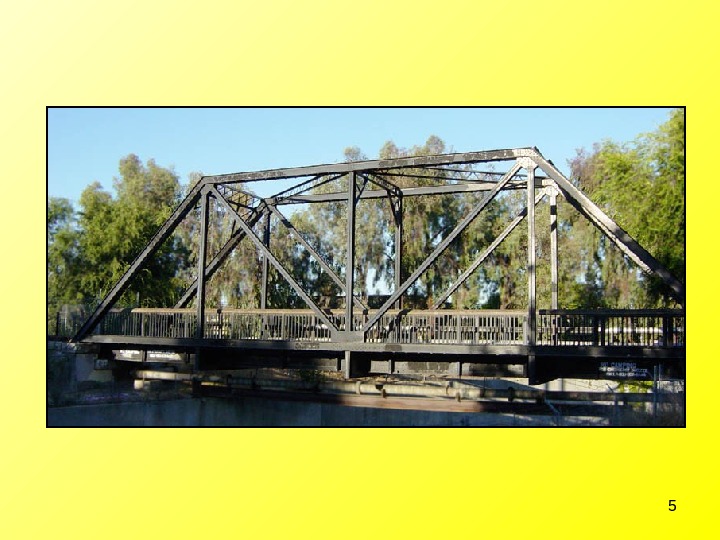
















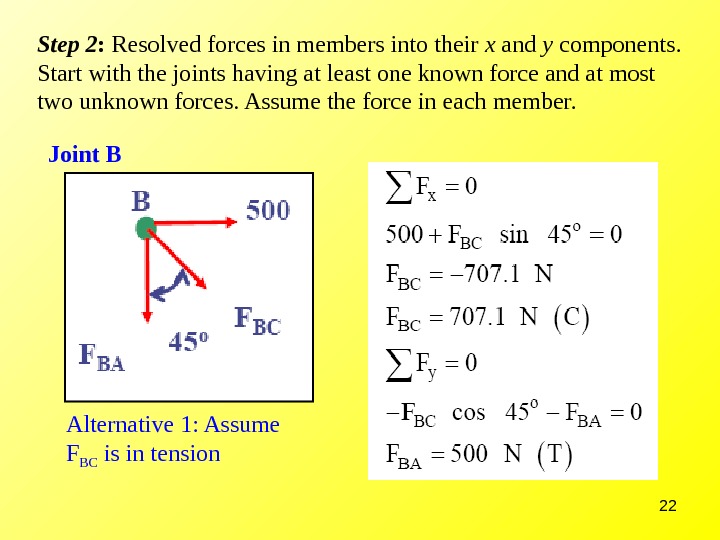







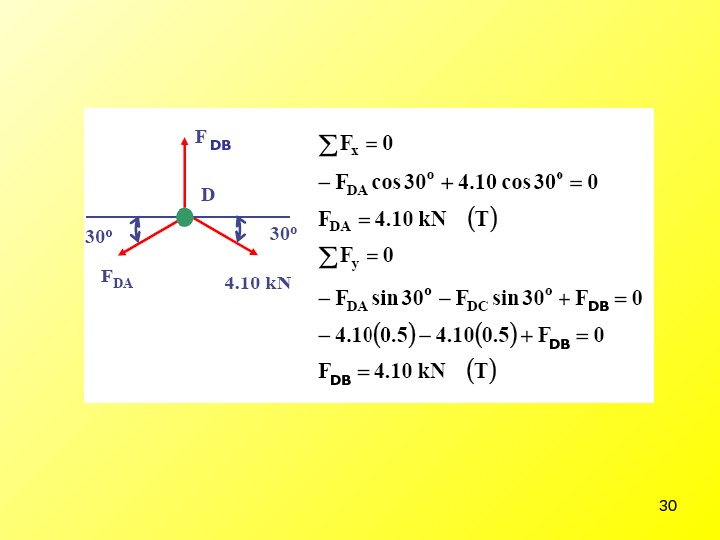


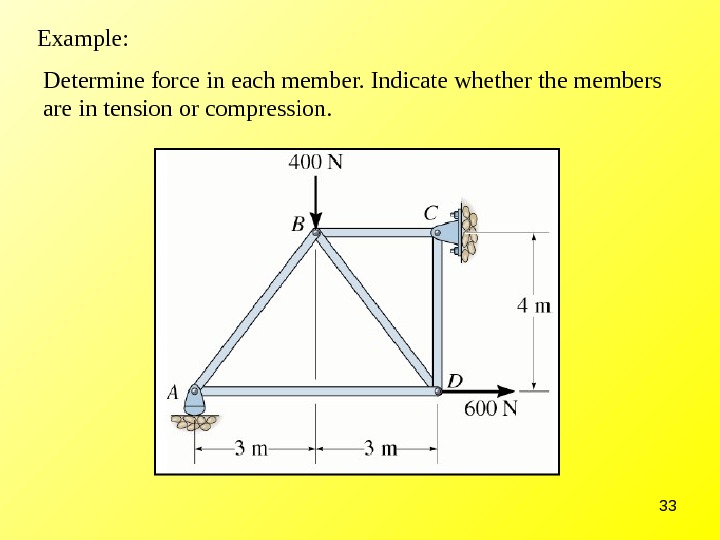


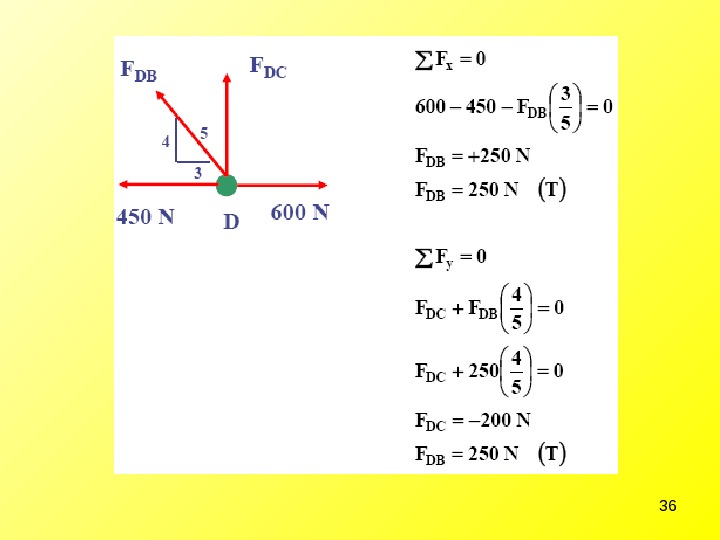








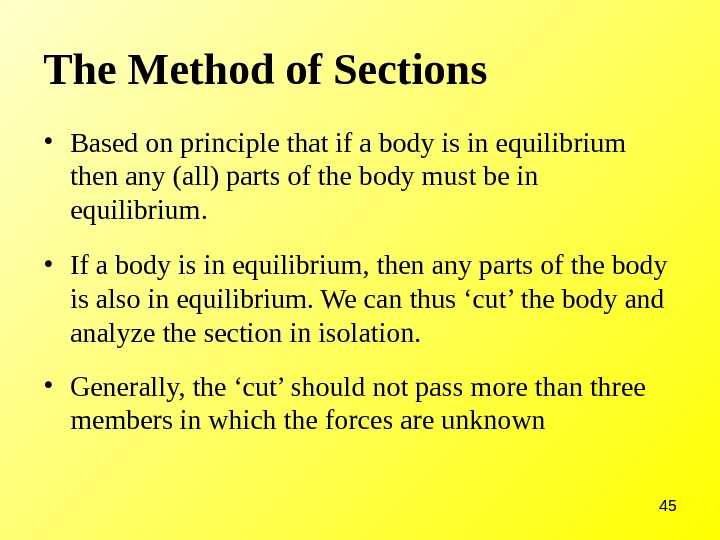

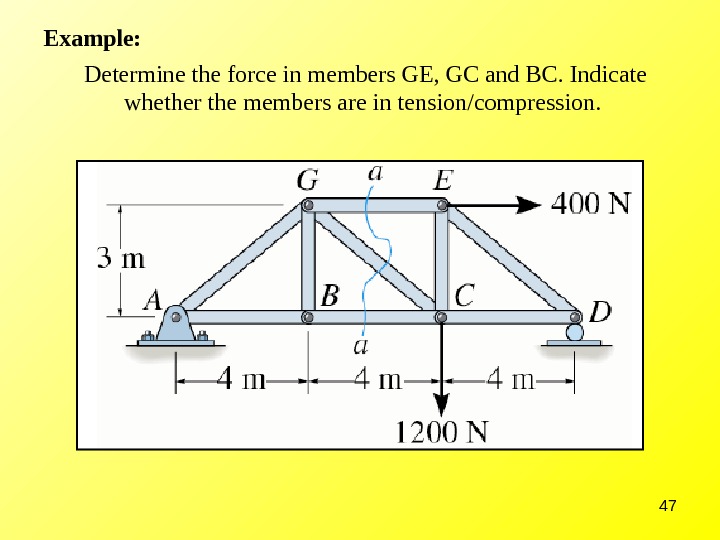














- Размер: 3.8 Mегабайта
- Количество слайдов: 61
Описание презентации Structural Analysis of Trusses – Method of Joints по слайдам
 Structural Analysis of Trusses – Method of Joints
Structural Analysis of Trusses – Method of Joints
 2 Simple Trusses
2 Simple Trusses
 3 Truss • Definition: A truss is a structure composed of slender members joined together at their end points. The members are usually made of wood or metal • Steel trusses: Joints are usually formed by bolting or welding the members to a common plate, called a gusset plate, or simply passing a large bolt through each member.
3 Truss • Definition: A truss is a structure composed of slender members joined together at their end points. The members are usually made of wood or metal • Steel trusses: Joints are usually formed by bolting or welding the members to a common plate, called a gusset plate, or simply passing a large bolt through each member.








 12 Planar Trusses • What we will encounter most frequently is planar truss structure. • Planar truss structures are structures which can be assumed to lie in a single plane and are often used to support roof and bridges.
12 Planar Trusses • What we will encounter most frequently is planar truss structure. • Planar truss structures are structures which can be assumed to lie in a single plane and are often used to support roof and bridges.


 15 Assumptions for Design • To design truss structure and its connections, it is first necessary to determine force in each member. • Newton’s First and Third Law will be used to solve the equilibrium equations.
15 Assumptions for Design • To design truss structure and its connections, it is first necessary to determine force in each member. • Newton’s First and Third Law will be used to solve the equilibrium equations.
 16 • General assumptions concerning truss structures are: 1. All loadings are applied at the joints 2. The weights of the members are neglected. 3. All members are two force members 4. The members are joined together by smooth pins. • Note: 1. To prevent collapse, the framework of a truss must be rigid 2. The simplest framework which is rigid and stable is a triangle. 3. Therefore, a triangle is the building block of all truss structures.
16 • General assumptions concerning truss structures are: 1. All loadings are applied at the joints 2. The weights of the members are neglected. 3. All members are two force members 4. The members are joined together by smooth pins. • Note: 1. To prevent collapse, the framework of a truss must be rigid 2. The simplest framework which is rigid and stable is a triangle. 3. Therefore, a triangle is the building block of all truss structures.
 17 The Method of Joints • It is important to know that for equilibrium of forces, the sufficient condition is External Force = Internal Force • External force: reaction forces, applied forces • Internal force: tension/compression force set up in the member
17 The Method of Joints • It is important to know that for equilibrium of forces, the sufficient condition is External Force = Internal Force • External force: reaction forces, applied forces • Internal force: tension/compression force set up in the member
 18 • To analyze a truss structure using method of joint, these steps are useful: 1. Draw the free-body diagram of a joint having at least one known force and at most two unknown forces. 2. Orient the x- and y -axes such that the force can be resolved into their x and y components 3. Apply force equilibrium equations 4. Continue to analyze each of the other joints by repeating procedure (i) to (iii) 5. A member in compression (C) “pushes” on the joint and a member in tension (T) “pulls” on the joints. Normally, take compression as –ve and tension as +ve.
18 • To analyze a truss structure using method of joint, these steps are useful: 1. Draw the free-body diagram of a joint having at least one known force and at most two unknown forces. 2. Orient the x- and y -axes such that the force can be resolved into their x and y components 3. Apply force equilibrium equations 4. Continue to analyze each of the other joints by repeating procedure (i) to (iii) 5. A member in compression (C) “pushes” on the joint and a member in tension (T) “pulls” on the joints. Normally, take compression as –ve and tension as +ve.
 19 Note: • In the beginning of a calculation, ignore all the compression/tension sign. • Start off by simply labeling each member consistently according to the applied force (a little bit of common sense is required here). • The final calculated numerical values will tell us if we have labeled the members correctly.
19 Note: • In the beginning of a calculation, ignore all the compression/tension sign. • Start off by simply labeling each member consistently according to the applied force (a little bit of common sense is required here). • The final calculated numerical values will tell us if we have labeled the members correctly.
 20 Example: Determine force in each member of the truss shown. Indicate if the members are in tension/compression
20 Example: Determine force in each member of the truss shown. Indicate if the members are in tension/compression
 21 Step 1 : Draw the free-body diagram & determine the support reactions
21 Step 1 : Draw the free-body diagram & determine the support reactions
 22 Step 2 : Resolved forces in members into their x and y components. Start with the joints having at least one known force and at most two unknown forces. Assume the force in each member. Joint B Alternative 1: Assume F BC is in tension
22 Step 2 : Resolved forces in members into their x and y components. Start with the joints having at least one known force and at most two unknown forces. Assume the force in each member. Joint B Alternative 1: Assume F BC is in tension
 23 Alternative 2: Assume F BC is in compression
23 Alternative 2: Assume F BC is in compression
 24 Joint
24 Joint
 25 Joint
25 Joint
 26 Step 3 : Complete the force distribution diagram
26 Step 3 : Complete the force distribution diagram
 27 Example: Determine force in each member of the truss shown. Indicate if the members are in tension/compression.
27 Example: Determine force in each member of the truss shown. Indicate if the members are in tension/compression.
 28 Step 1 : Draw the free-body diagram & determine the support reactions A CB D – ve +ve
28 Step 1 : Draw the free-body diagram & determine the support reactions A CB D – ve +ve
 29 Step 2 : Calculate forces at the joints
29 Step 2 : Calculate forces at the joints


 32 Step 3 : Complete the force distribution diagram
32 Step 3 : Complete the force distribution diagram
 33 Determine force in each member. Indicate whether the members are in tension or compression. Example:
33 Determine force in each member. Indicate whether the members are in tension or compression. Example:
 34 Step 1 : Draw the free-body diagram & determine the support reactions – ve +ve B D +ve
34 Step 1 : Draw the free-body diagram & determine the support reactions – ve +ve B D +ve
 35 Step 2 : Calculate forces at the joints
35 Step 2 : Calculate forces at the joints


 38 Step 3 : Complete the force distribution diagram
38 Step 3 : Complete the force distribution diagram
 Structural Analysis of Trusses – Method of Sections
Structural Analysis of Trusses – Method of Sections
 40 Zero-Force Members • Our analysis can be greatly simplified if one can identify those members that support no loads. We call these zero-force members. • These members can used to increase the stability of the truss during construction and to provide support if the applied loading is change.
40 Zero-Force Members • Our analysis can be greatly simplified if one can identify those members that support no loads. We call these zero-force members. • These members can used to increase the stability of the truss during construction and to provide support if the applied loading is change.
 41 • Rule 1 : If only two members form a truss joint and no external load or support reaction is applied to the joint, the members must be a zero-force member.
41 • Rule 1 : If only two members form a truss joint and no external load or support reaction is applied to the joint, the members must be a zero-force member.
 42 • Rule 2 : If three members form a truss joint for which two of the members are collinear, the third member is a zero-force member provided no external force or support reaction is applied to the joint. F DA & F CA are zero-force members
42 • Rule 2 : If three members form a truss joint for which two of the members are collinear, the third member is a zero-force member provided no external force or support reaction is applied to the joint. F DA & F CA are zero-force members
 43 Which are the zero-force members?
43 Which are the zero-force members?

 45 The Method of Sections • Based on principle that if a body is in equilibrium then any (all) parts of the body must be in equilibrium. • If a body is in equilibrium, then any parts of the body is also in equilibrium. We can thus ‘cut’ the body and analyze the section in isolation. • Generally, the ‘cut’ should not pass more than three members in which the forces are unknown
45 The Method of Sections • Based on principle that if a body is in equilibrium then any (all) parts of the body must be in equilibrium. • If a body is in equilibrium, then any parts of the body is also in equilibrium. We can thus ‘cut’ the body and analyze the section in isolation. • Generally, the ‘cut’ should not pass more than three members in which the forces are unknown

 47 Determine the force in members GE, GC and BC. Indicate whether the members are in tension/compression. Example:
47 Determine the force in members GE, GC and BC. Indicate whether the members are in tension/compression. Example:
 48 Step 1 : Calculate the reaction force
48 Step 1 : Calculate the reaction force
 49 Step 2 : Section the structure
49 Step 2 : Section the structure
 50 Example: Determine the force in member CF.
50 Example: Determine the force in member CF.
 51 Taking moment about A, ∑ M A = 0 = E y (16) – 5(8) – 3(12) E y = 4. 75 k. N ∑ F y = 0 = A y + 4. 75 – 3 A y = 3. 25 k. NStep 1 : Calculate the reaction force
51 Taking moment about A, ∑ M A = 0 = E y (16) – 5(8) – 3(12) E y = 4. 75 k. N ∑ F y = 0 = A y + 4. 75 – 3 A y = 3. 25 k. NStep 1 : Calculate the reaction force
 52 Step 2 : Section the structure From similar triangles, x can be obtained: xx 8 6 4 4 x = 4 m
52 Step 2 : Section the structure From similar triangles, x can be obtained: xx 8 6 4 4 x = 4 m
 53 Example: Determine the force in member EB Step 1 : Calculate the reaction forces
53 Example: Determine the force in member EB Step 1 : Calculate the reaction forces
 54 Step 2 : Section the structure Notice that we cannot cut through section b-b. To reduce the section b-b into 2 unknowns, we have to cut through section a-a first. Taking moments about B, ∑ M B = 0 1000(4) + 3000(2) – 4000(4) – F ED sin 30° (4) = 0 F ED = – 3000 N F ED = 3000 N (C)
54 Step 2 : Section the structure Notice that we cannot cut through section b-b. To reduce the section b-b into 2 unknowns, we have to cut through section a-a first. Taking moments about B, ∑ M B = 0 1000(4) + 3000(2) – 4000(4) – F ED sin 30° (4) = 0 F ED = – 3000 N F ED = 3000 N (C)
 55 Consider now the free-body diagram of section b-b :
55 Consider now the free-body diagram of section b-b :
 56 Different Types of Roof Trusses KING POST
56 Different Types of Roof Trusses KING POST



 60 Types of bridge trusses
60 Types of bridge trusses


